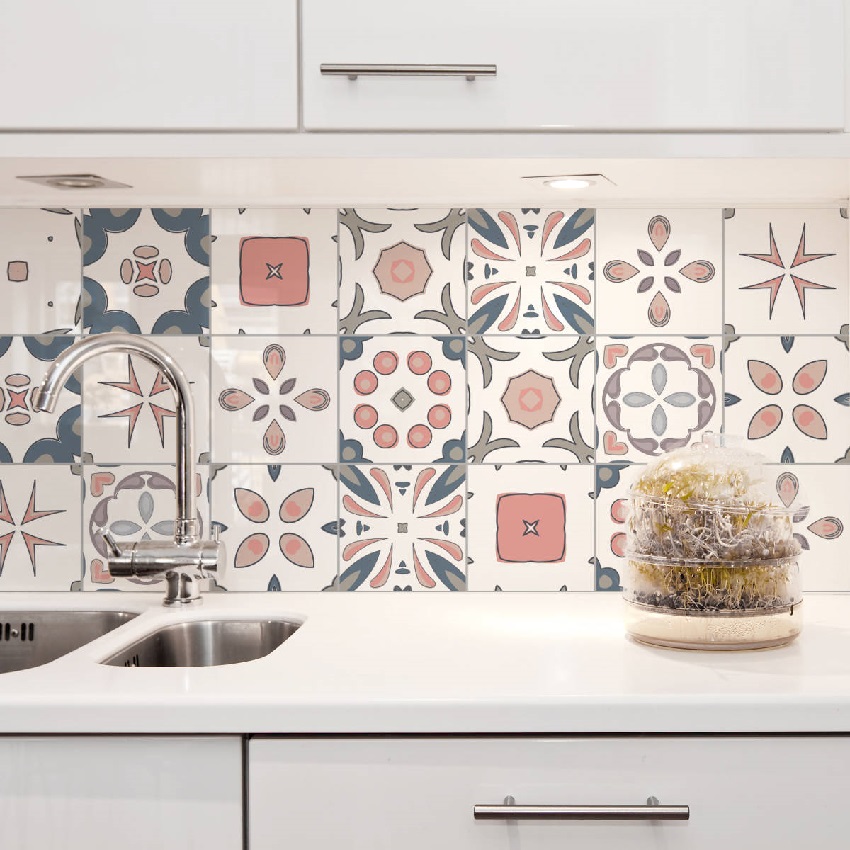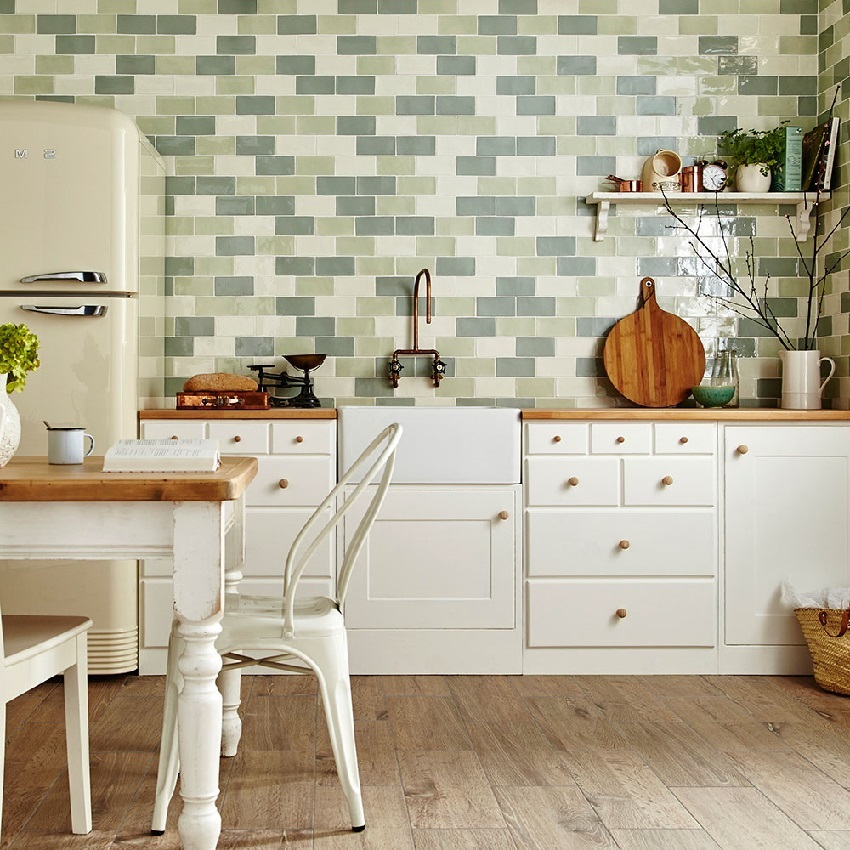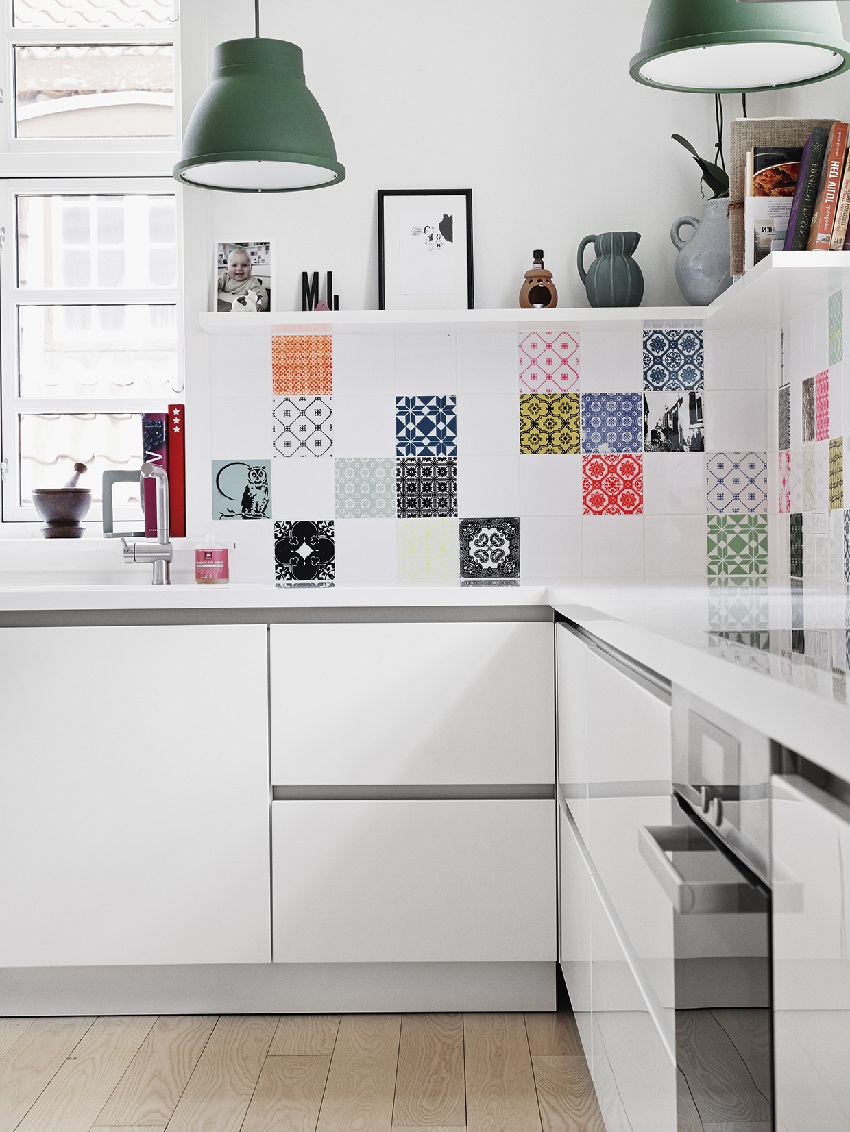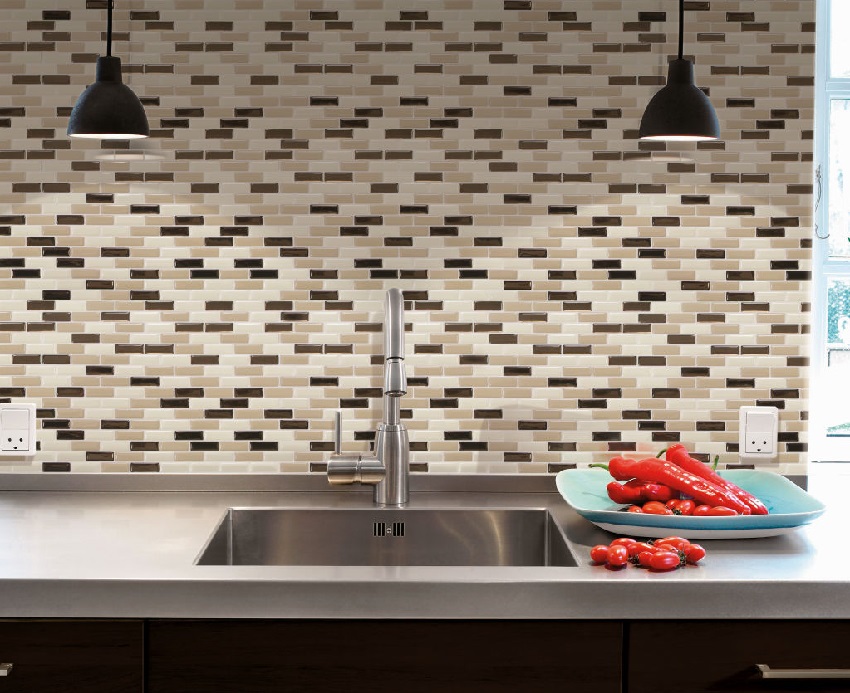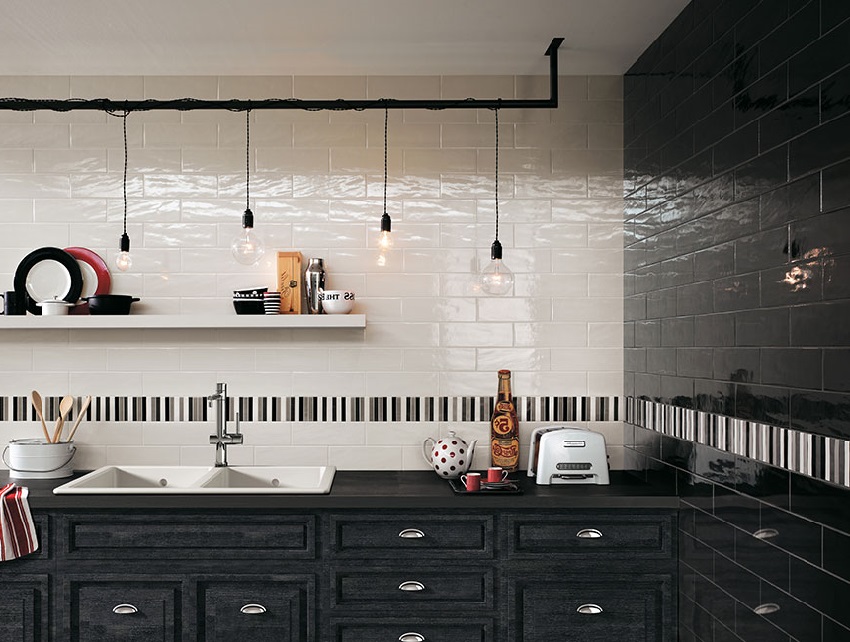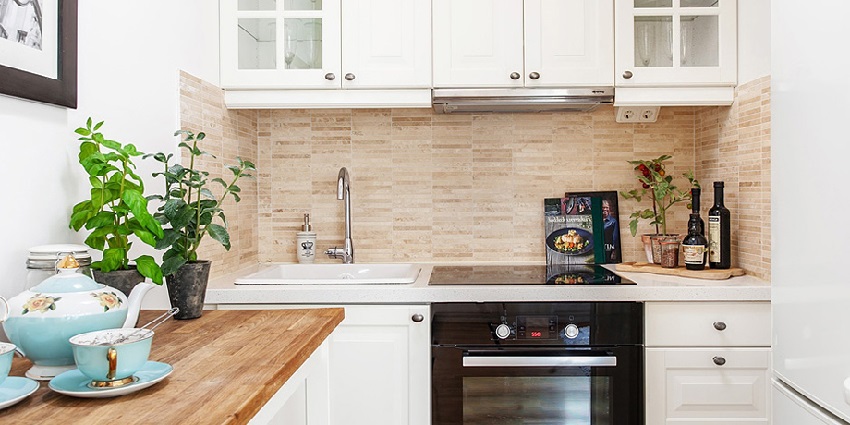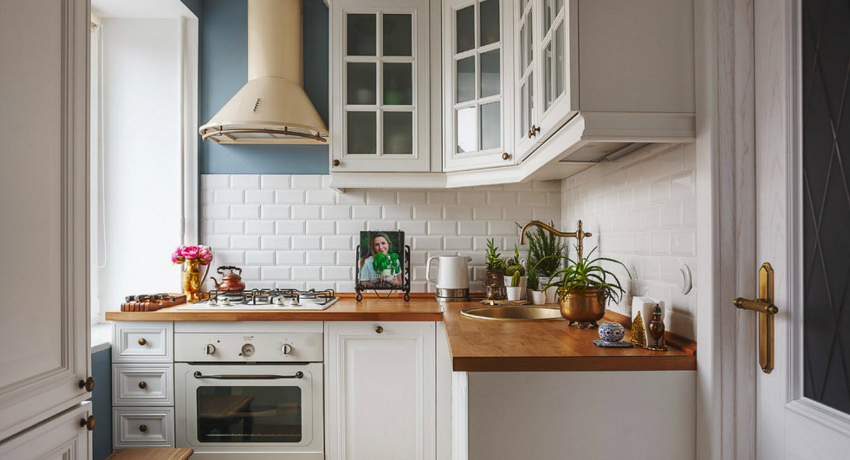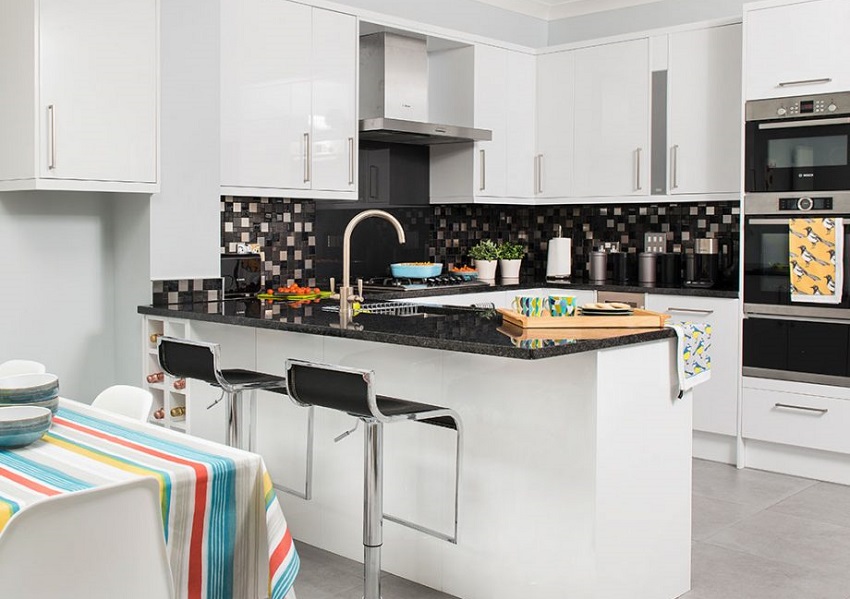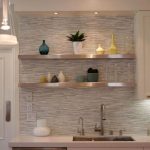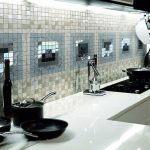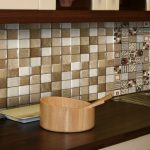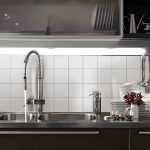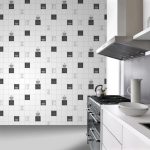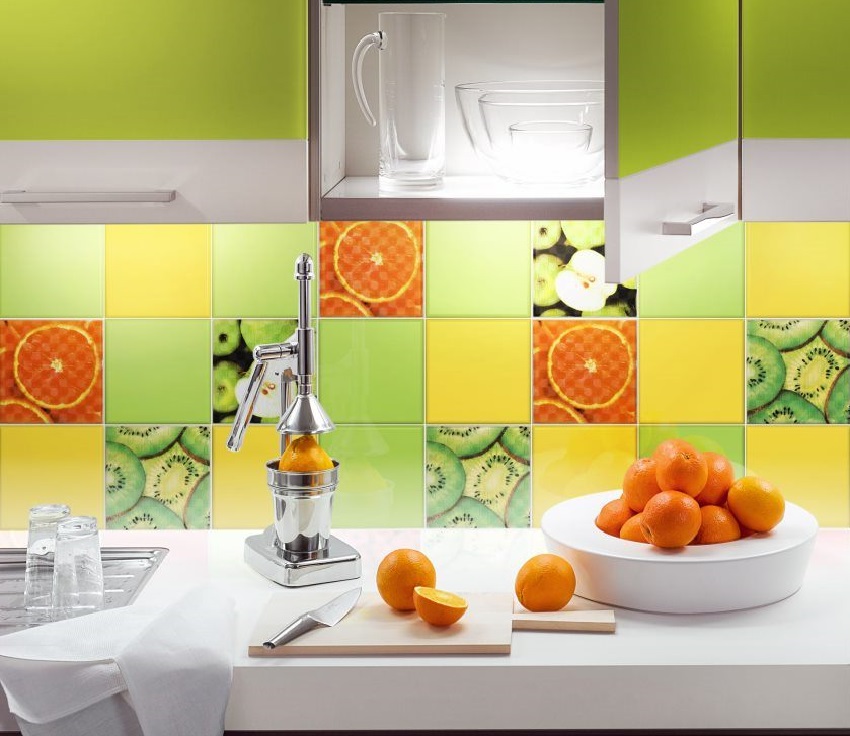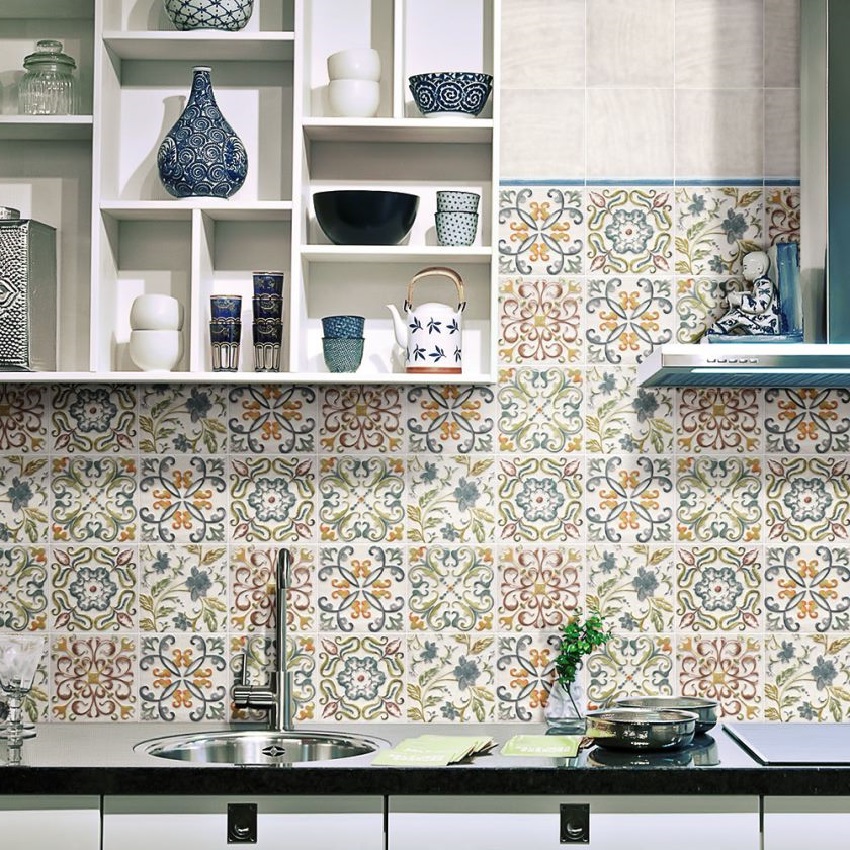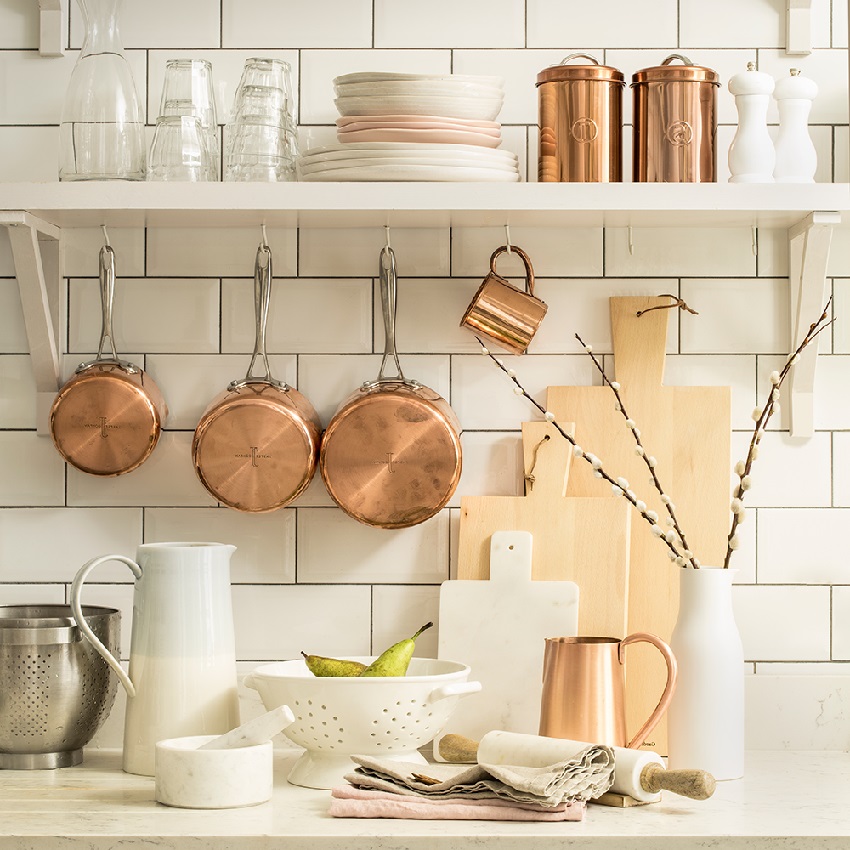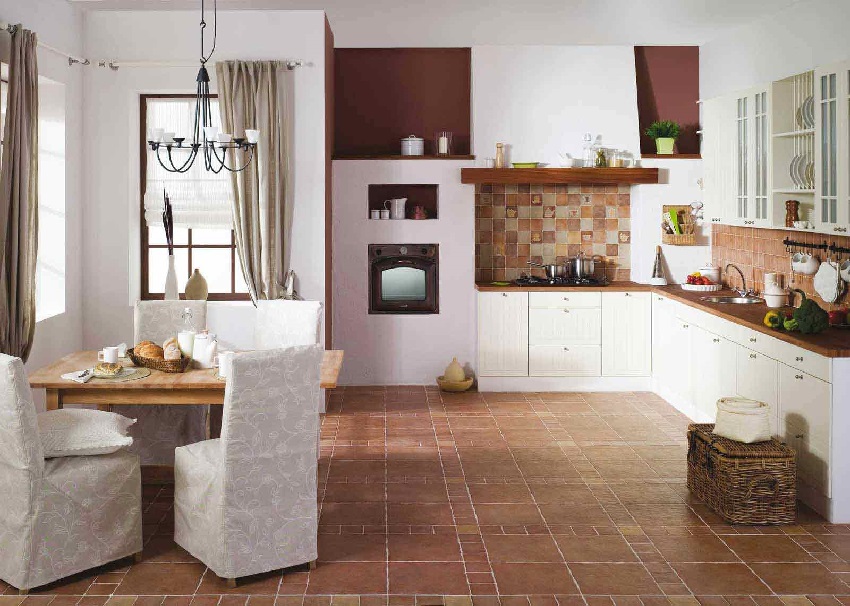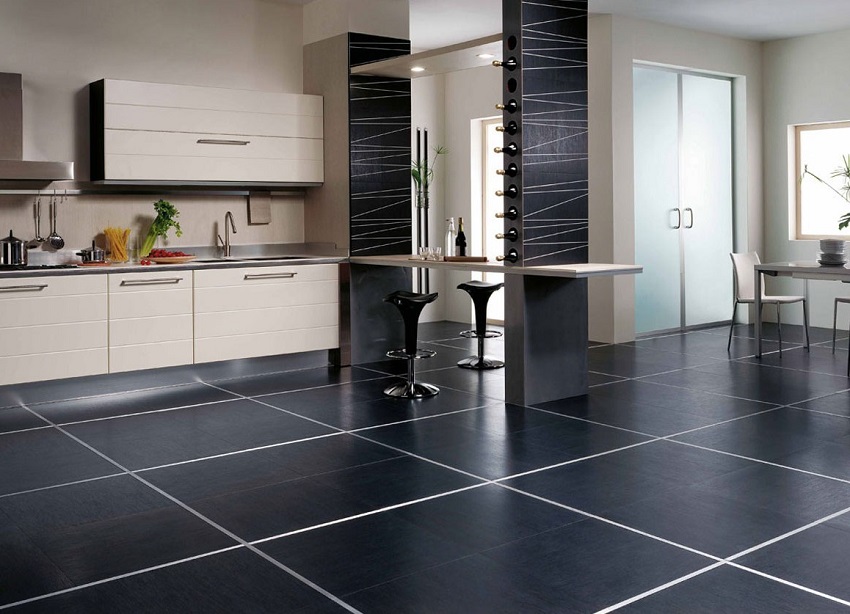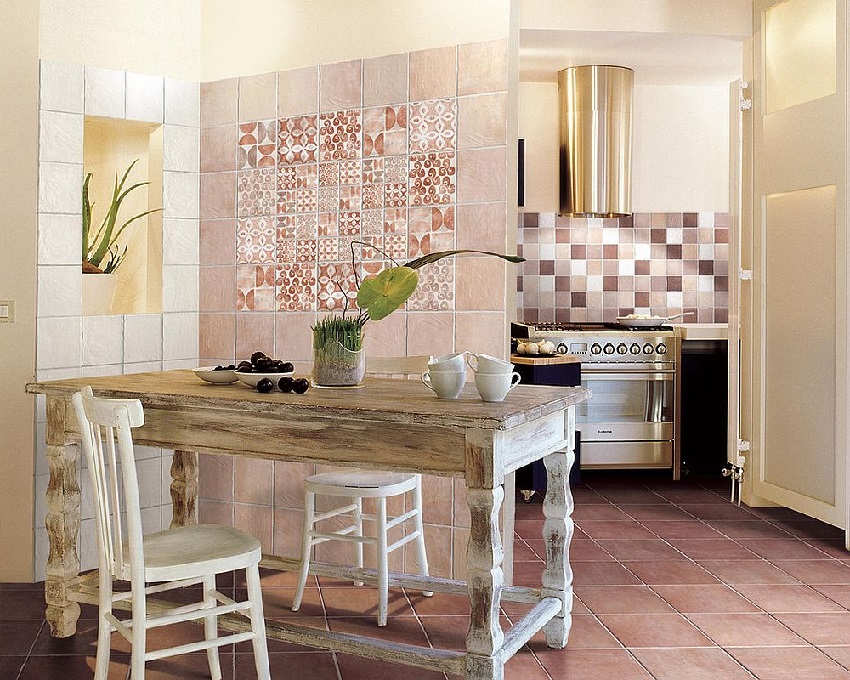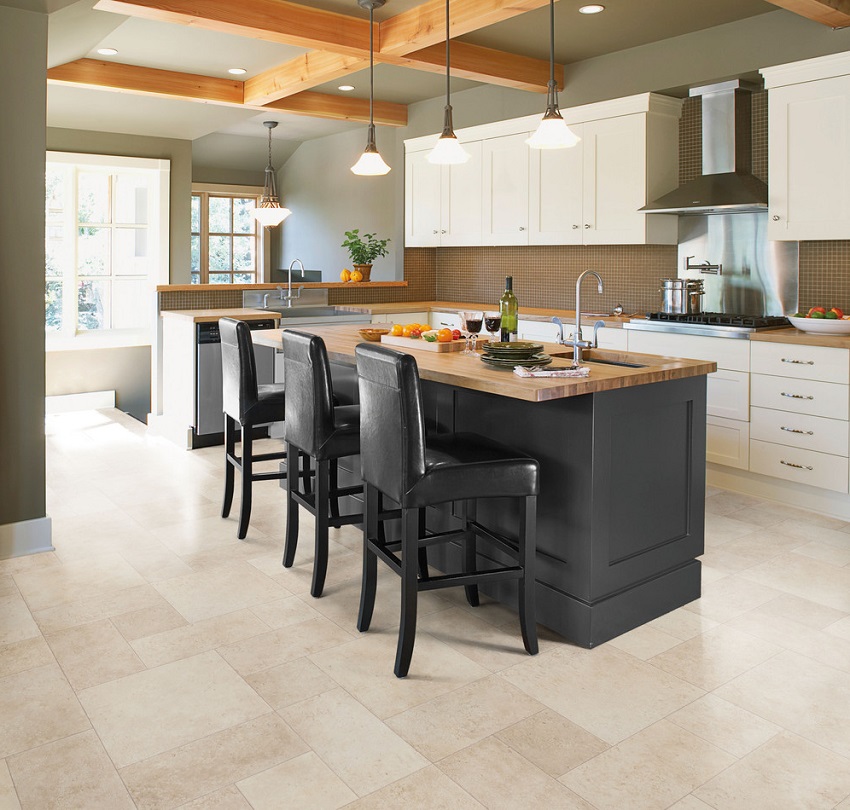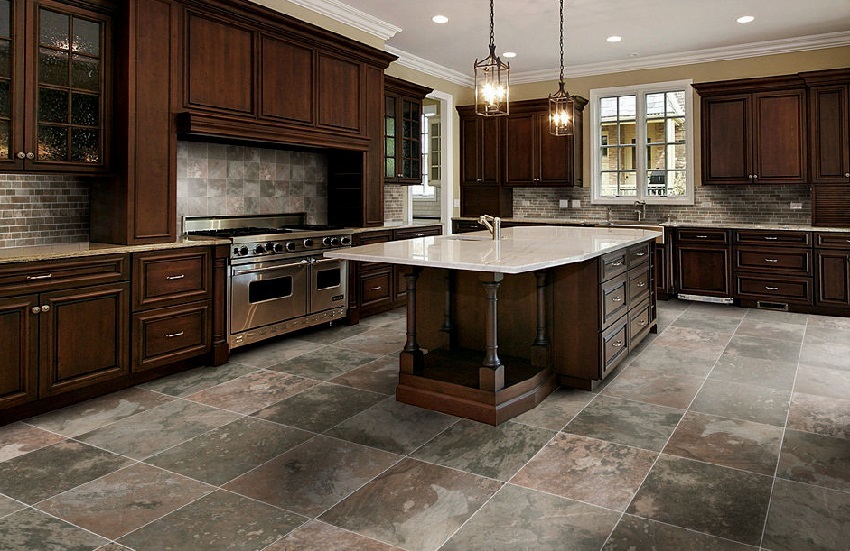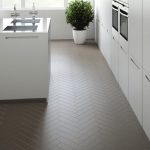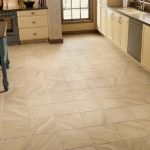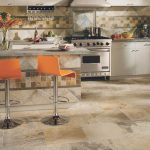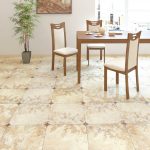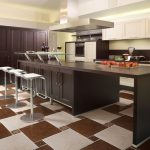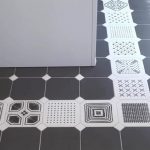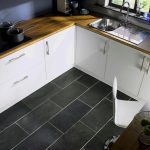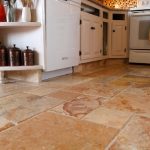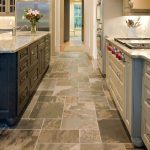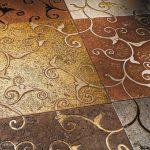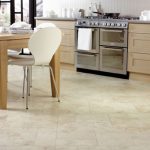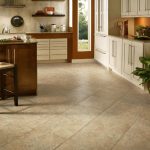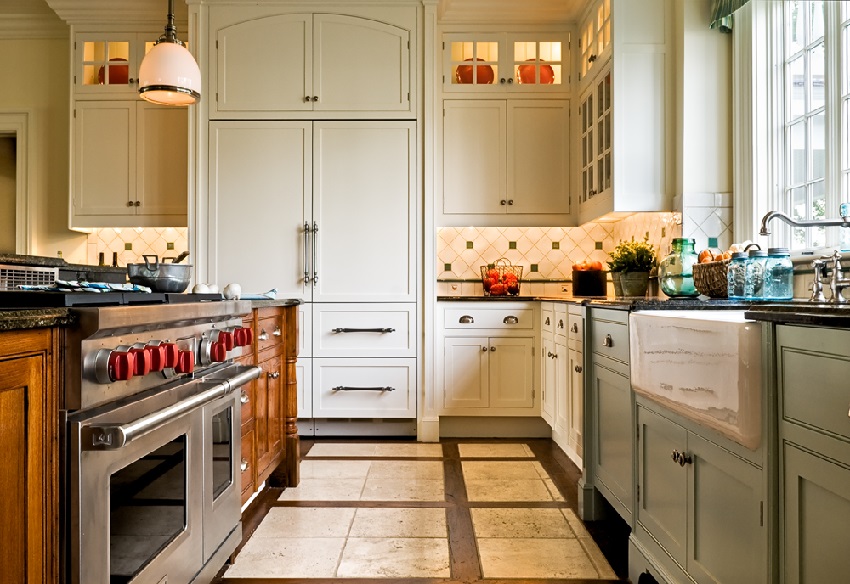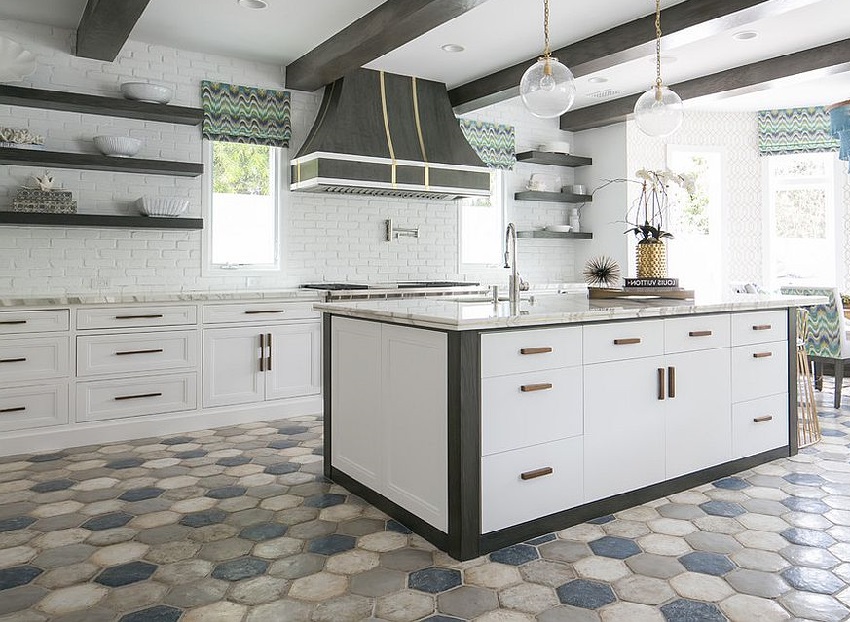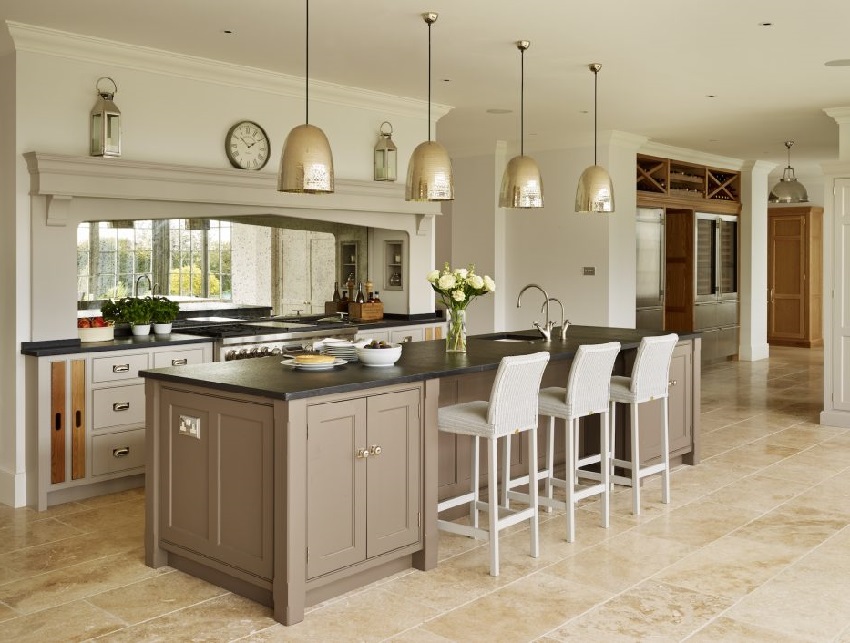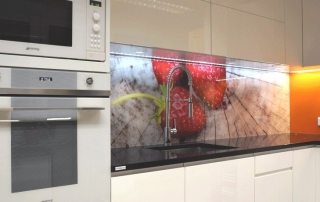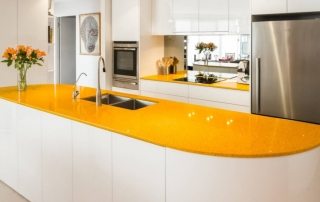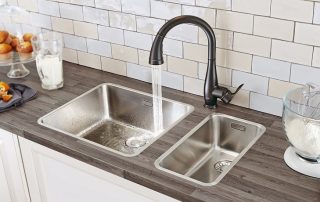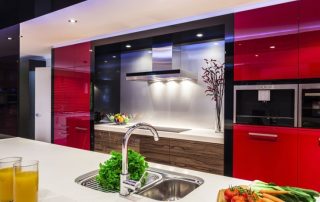Ceramic tiles are an attractive and easy-care material that is considered ideal when it comes to decorating a kitchen. But in order to choose the most suitable option, you need to understand what characteristics ceramic tiles for the kitchen should have and what properties you should pay special attention to when buying.
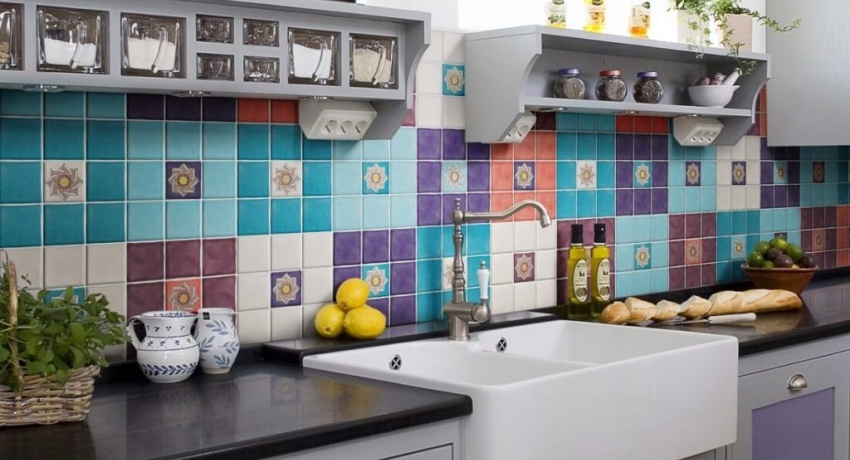
Bright tile apron in design country style kitchens
Content [Hide]
- 1 What should be ceramic tiles for the kitchen: the choice of material for the apron
- 2 What to look for before buying backsplash tiles for the kitchen
- 3 Popular tile formats in the kitchen: laying the apron in various ways
- 4 How to diversify an apron for a kitchen from tiles: photo designs
- 5 How to choose floor tiles for the kitchen: parameters and criteria
- 6 Advantages and Disadvantages of Using Ceramic Tiles for Kitchen Floor
- 7 Which tile to choose for the kitchen on the floor: material classification
- 8 How to choose tiles for the kitchen on the floor: photos of the best interior solutions
What should be ceramic tiles for the kitchen: the choice of material for the apron
The most common use for kitchen wall tiles is to create a backsplash that sits directly above the work surface. Choosing a tile for this purpose is based on the following rules:
- glossy tiles are an excellent solution if there is a need to visually expand the space, at the same time, it is easy to clean. The only drawback of this solution is the fact that traces of water falling on the surface, as well as fat, are visible on its surface;
- tile for kitchen wall should not be embossed. Given the fact that all kitchen surfaces are prone to contamination, it will be much easier to thoroughly clean smooth tiles. Therefore, it is better to immediately refuse from exquisite embossed finishing materials;
- white tiles are ideal tiles for an apron in the kitchen. Mosaic can be used to liven up the interior, but otherwise, decoration in light colors is a win-win;
- if you want to mess around with cleaning as little as possible, it is best to buy ceramic tiles for the kitchen in a beige or light brown shade. On such a surface, dirt and dried water droplets are least noticeable.
The main difficulty that one has to face during the operation of the tile covering in the kitchen is the tile joints. It is in them that dirt usually accumulates, which makes the cladding unattractive. Therefore, before putting tiles in the kitchen, it is necessary to purchase a high-quality grout that is resistant to moisture and does not serve as a favorable environment for the growth of fungi and mold.
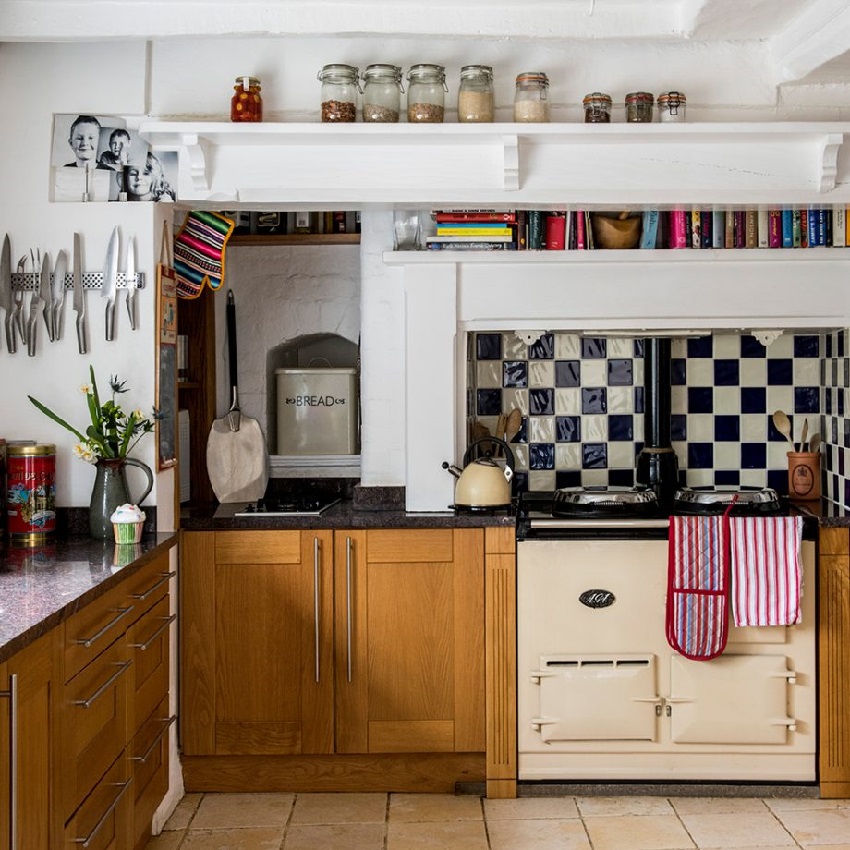
Black and white square tiles in decoration kitchen apron
Helpful advice! As a solution to the problem of contamination of joints, you can try laying rectified tiles. This means that the tile has perfectly straight edges and fits almost closely, so that the distance between the elements does not exceed 2 mm.
What to look for before buying backsplash tiles for the kitchen
In the process of choosing ceramic tiles for a kitchen apron, you should pay attention to the presence of a special protective coating that prevents the destruction of tiles as a result of exposure to active chemicals. This will allow you to clean faster, cleaning the surface with special products that effectively remove grease and dirt. Manufacturers designate such material by marking it with marks A or AA.
Another important aspect that can be encountered unknowingly is the difference in the shades of tiles of the same model, but in different batches. This is considered acceptable in some way, as the shade may become slightly lighter or darker during the firing process. And if you lay such material next to each other, then the difference will be noticeable, so before buying it is worth comparing the tiles from all packages.
Another parameter that you need to know about in advance is the caliber. With its help, manufacturers indicate how much the actual size of the elements can differ from the declared one. Ideally, the caliber should be zero or, in extreme cases, not exceed 1.
It is advisable to carry out a visual inspection of all the elements from the packaging before buying to make sure that the glaze applied to them is even and smooth, and the elements themselves are not damaged - cracks, chips and scuffs.
Helpful advice! If after purchasing the material there is a need to store it for some time, then this should be done in a dry and well-ventilated room. Otherwise, after a few months, the material may crack and become unusable.
How to calculate the required amount of tiles for a kitchen apron
In order not to have to additionally buy material, or, conversely, there was not too much surplus, before buying it is worth calculating how much tile is actually needed. If the tiles are planned to be laid in the traditional way, then usually another 5-10% is added to the required amount. For more complex patterns, the margin should be at least 15%.
It is important to understand that in addition to the mandatory trimming of some elements, which, in one way or another, leads to an increase in the amount of material spent, you have to deal with a production defect. Usually, in a batch of tiles from a domestic manufacturer of an average price category, defective products are about 5%.
Helpful advice! It is advisable that after installation you have a few whole tiles left, which can be left in case you need to replace individual sections of the coating.
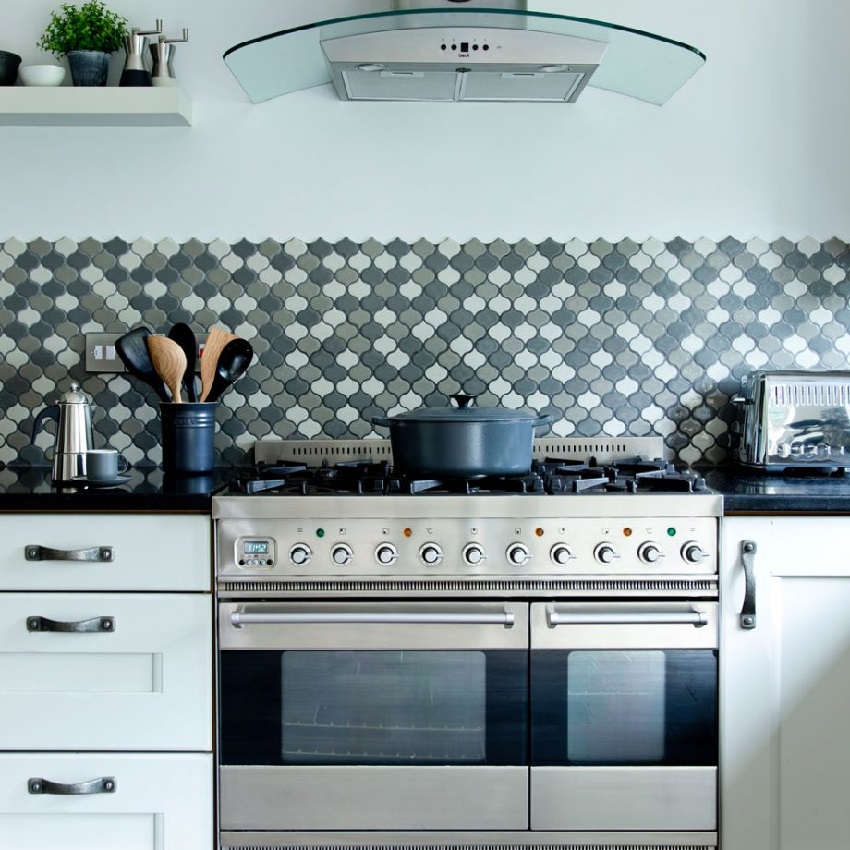
Small tiles of original shape in the interior of the kitchen
Popular tile formats in the kitchen: laying the apron in various ways
Looking through a photo of tiles on the wall in the kitchen, you need to understand that not every material that looks good on its own will look advantageous as an apron. Therefore, it is worth considering in advance the most popular options that are best suited for this purpose:
- Ceramic tiles 10x10. In the photo catalog of kitchen tiles, this option takes a leading position. Unlike the larger format, it requires significantly less pruning, which means that the consumption is significantly lower. This is an excellent option for a small-sized room, since it is able to visually expand the space without overloading it. Another advantage of this solution is the ability to comfortably produce cladding in hard-to-reach places. In addition, it goes well with any mosaics and interspersed with other elements. Among the shortcomings, it is worth noting only a relatively complex installation procedure, which requires a certain experience from the master.
- Ceramic tiles for brick.This option has gained popularity quite recently and is often called "hog" because of the beveled chamfers around the edges. In shape, such elements are very similar to small bricks. These tiles are perfect for modern kitchens as well as for a strict classic interior. You can find such tiles in different sizes, as well as shapes and colors. The standard size of such elements is considered to be 7.5x15 cm, although they often say this about a 10x20 tile.
Related article:
Kitchen renovation: design, photos of real interiors and a choice of finishing materials
Advice on the choice of materials, apron design. Design tricks for a small kitchen. Turnkey repair and cosmetic.
- Usually "hog" is called a plain tile, the surface of which is smooth and glossy. Among the color solutions, calm tones, in particular, white and brown, will be more popular. But at the same time, in the photo catalogs of apron tiles in the kitchen, you can find a large selection of shades and even elements with photo printing.
- Mosaic tiles for the kitchen. The price of such a solution will be slightly higher than in the case of the previous options, but the result is undoubtedly worth it. The surface of this material imitates a real mosaic, which adds a special beauty to the finish. Of course, taking care of such an apron will be somewhat more difficult, but if you clean it regularly, then it is quite possible to keep the surface clean.
Helpful advice! One of the best manufacturers offering quality kitchen backsplash tiles is Kerama Marazzi. In the catalog of this company, you can find many options that meet any requirement. In addition, the tiles for the Kerama Marazzi kitchen are a domestic product, which has a positive effect on its cost.
How to diversify an apron for a kitchen from tiles: photo designs
In order for the tile cladding not to look boring and monotonous, you can combine materials, creating the most unusual combinations. Here are some interesting ideas to make a tile backsplash the main decoration of your kitchen:
- kitchen tiles go well with flat, patterned inserts. In this case, the laying can be point-like (elements are evenly scattered over all surface areas) or in the form of a separate panel;
- using a decorative panel is another way to decorate a surface. Often this method is used for Provence or country interiors. The size of the insert can be almost anything, but it is desirable to arrange it symmetrically to indicate the center. The most common subjects for such panels are beautiful views of small towns with cute houses or food (cheese, fruits, berries, etc.). As examples, you can consider numerous photos of ceramic tiles for the kitchen with such images.
- frieze or border tile is another element used for decoration. Represents small rectangular elements that are laid out with a border in the upper or lower part of the apron. Although sometimes such a strip is placed in the very center.
In the catalogs of ceramic tiles for the kitchen, you can find a huge number of options for cladding materials, as well as elements used as decorative inserts. So before putting tiles of the same color in the kitchen, it is worth considering all sorts of options to make the surface not only practical, but also beautiful.
How to choose floor tiles for the kitchen: parameters and criteria
An equally difficult task is the selection and installation of floor tiles in the kitchen. In this case, in order to choose the right option, it is worth paying attention to a number of characteristics that are important for this particular material:
- high level of wear resistance of the coating. This is of great importance, since the permeability in the kitchen is high and over time, low-quality tiles can be subject to erasure;
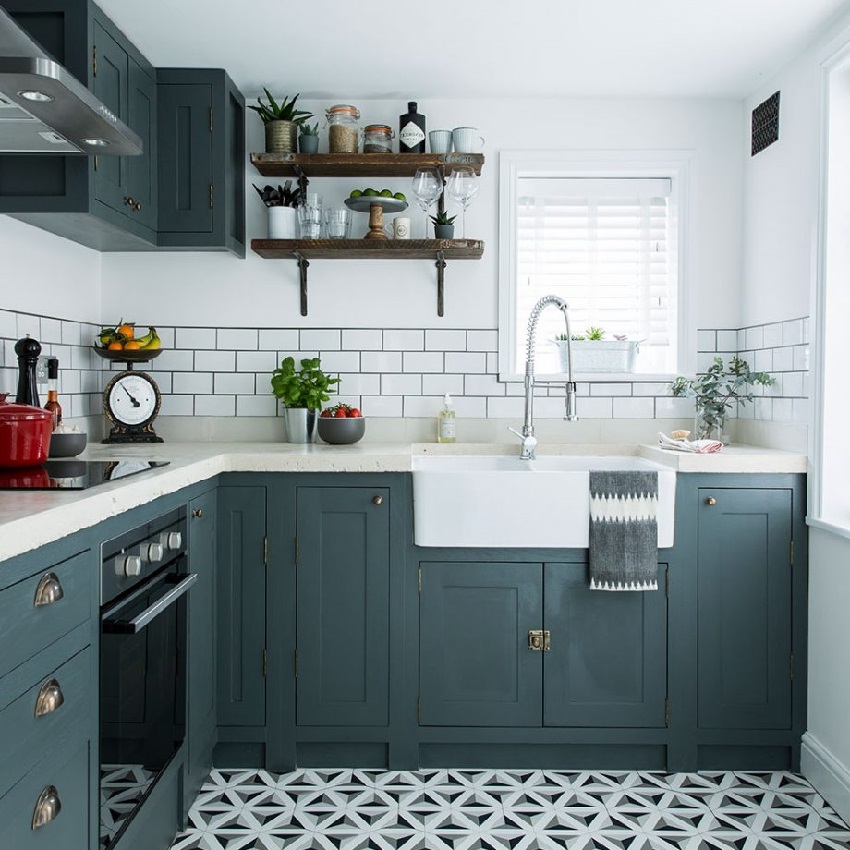
Kitchen floor from tiles
- the tile must be of sufficient thickness to withstand the loads to which it will be exposed as a result of the installation of pieces of furniture and large household appliances (refrigerator, gas stove, etc.);
- tiles on the floor for the kitchen and corridor must be resistant to the effects of active chemical compounds and not be destroyed as a result of constant exposure to steam and water.
Helpful advice! The weakest point of the tile covering is the tile joints. They are the ones most prone to moisture absorption and pollution. Therefore, it is worth buying a quality grout, which is intended directly for flooring.
Advantages and Disadvantages of Using Ceramic Tiles for Kitchen Floor
In addition to tiles, there are other finishing materials that are used as flooring in the kitchen. Let's consider what are the advantages of this option, and also pay attention to some of the disadvantages that we will have to face.
Pros of using tiles for kitchen flooring:
- the floor, for which the tiles were used, looks great and at the same time is easy to clean and hygienic;
- high-quality material is characterized by high strength and resistance to abrasion as a result of external factors;
- the tile is characterized by high resistance to moisture and chemicals;
- the tile is not subject to deformation and there is no risk that it will bend over time;
- the material is completely resistant to ultraviolet rays and does not fade in the sun;
- you can also talk about the maximum level of environmental cleanliness and safety for human health and the environment.
Important! The tile does not support combustion and in the event of a fire is one of the safest materials, since it does not emit any harmful substances.
Among the few shortcomings that were noted in this solution, it is worth noting:
- in comparison with some other finishing materials, the tile has a high cost and requires a slightly more complicated installation procedure;
- during operation, users often note that walking on tiles in the cold season is rather uncomfortable if floor heating is not provided;
- anything that falls on the tile is likely to break, so in the event of a fall, glass and ceramic dishes have extremely little chance of surviving.
This modest list of shortcomings is fully compensated for by the positive qualities that the owner receives by making a choice in favor of tiles. The main thing is to choose the highest quality material, the characteristics of which meet the requirements and will allow it to serve regularly for many years.
Which tile to choose for the kitchen on the floor: material classification
The huge assortment that is offered to buyers today can easily confuse the buyer with its diversity. All options differ from each other in size, shape, design, and technical characteristics.
Helpful advice! If you are not familiar with the material and its characteristics, then it is best to make a purchase in a specialized store, where a sales assistant can answer all your questions and recommend the best option.
The first thing you should pay attention to before buying kitchen floor tiles is marking.Material intended for use as a floor covering must be marked with a special icon, which shows a footprint. In addition, floor tiles have a special classification, which is officially adopted in European countries and in the USA. So, the following types of tiles are distinguished:
- PEI 1 is a wall tile that cannot be used as a floor covering;
- PEI 2 is a tile that can be used as a floor covering for rooms with low traffic - bathrooms or bedrooms, although this type of covering is rarely used in living rooms;
- PEI 3 - floor tiles designed for medium loads, which can be used to decorate any room in the house, except for the hallway;
- PEI 4 is a durable material that can withstand severe loads that it is subjected to as a result of use on staircases, hallways, etc.;
- PEI 5 is a tile with the highest indicators of strength and wear resistance, which is suitable for use in areas with the highest traffic.
It is best to buy floor tiles for the kitchen of the PEI 3 or PEI 4 class, because this is the only way you can not worry about the safety of the coating.
Another important parameter for the classification of tiles is their level of safety. This is also an extremely important indicator that you should pay attention to when buying. So, the division is done as follows:
- if the coefficient is higher than 0.75, then such a tile is considered safe;
- an indicator from 0.39 to 0.74 refers to a fairly safe material;
- in the range of 0.19-0.39 there is a tile that can be dangerous;

Interesting way of laying ceramic tiles on the floor
- anything below 0.19 denotes an extremely dangerous tile.
Helpful advice! Usually, after washing, the tiles become very slippery and can pose a real threat to the safety of people. Therefore, it is worth paying attention in advance to such an indicator as slip resistance.
- best tiles for kitchen
- kitchen floor tiles gray
- Luxury Vinyl Tile Flooring
How to choose tiles for the kitchen on the floor: photos of the best interior solutions
The choice of tile design is no less important and complex issue than its technical characteristics. First of all, the coating should be in harmony with the general interior of the room, so you should pay attention to all sizes, colors and shapes of the coating, choosing the one that will suit the best.
For those who want to save themselves the hassle associated with the selection of perfectly matching tiles for walls and floors, you can consider the option of purchasing ready-made sets. This will allow you to decorate the room in the same style.
But if you nevertheless decide to independently engage in the selection of material, then here are some recommendations that may be useful:
- large tiles are much easier to lay, but at the same time they tend to visually reduce the space, which is not very good in the case of small rooms;
- small tiles expand the space, but it will be much more difficult to install it yourself. In addition, all mistakes made during the installation process will be more noticeable;
- the choice of pattern should also be based on the size of the room: a small and simple pattern will visually expand the space, and a large and complex one will reduce it;
- choosing a monochromatic glossy floor covering for the kitchen is a risky option, since even the smallest pollution will be instantly noticeable. It will be much easier to care for a matte surface, for example, with a small pattern in the form of specks or streaks.
It can be difficult to choose the right tile among the huge variety of options offered.But it is extremely important to try to take into account as many significant factors and characteristics as possible, which in the future may affect the quality of material exploitation. Well, as a source of inspiration for choosing a suitable design, you can use a photo of ceramic tiles for the kitchen on an apron and as a floor covering.
